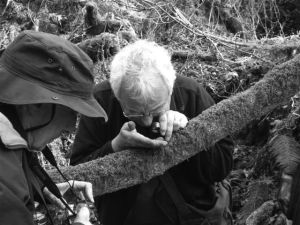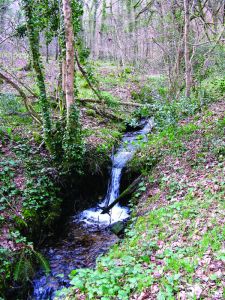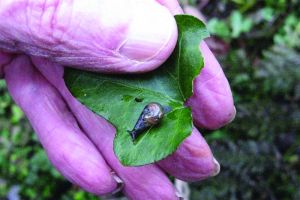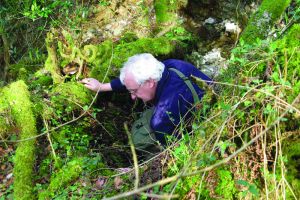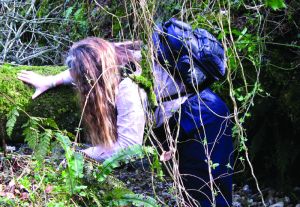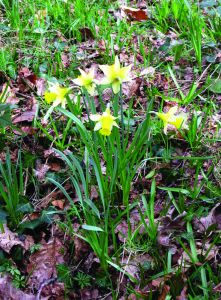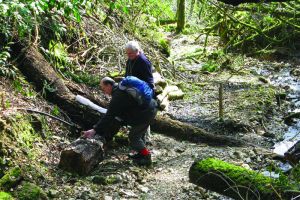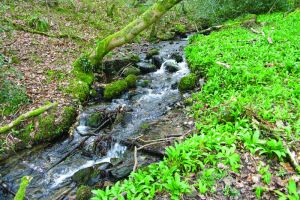|
Phenacolimax major is an elusive species; its habits and ecology are poorly documented. A lot of time over the weekend was therefore spent discussing what we do know – or rather what we think we know – and whether this applied to the sites we were visiting. The known sites tend to be relatively undisturbed ancient woodlands, where humidity is maintained at a permanently high level by the presence of springs, wet seepages, and/or streams beneath a relatively dense canopy of broadleaved trees, but where the ground is not subject to flooding. The sites also tend to be well-sheltered, out of the drying wind. The snails are found amongst moss, leaf litter and other debris on the soil surface, and often demand considerable search effort to locate. South-east Devon is one of the very few strongholds for the species known in Britain and was an obvious target area for Conch Soc’s distributional project on the species. Eighteen sites are known in the county and this field meeting targeted three of these and also explored further afield. Saturday was spent in the Teign Valley above Steps Bridge. Bridford Wood is the only known site in Dartmoor National Park – discovered here by Dave Bolton in 1992 - and so most of our time was spent here. A stream cuts down through the western end of the wood and has created a broad area of nutrient enriched wet-flushed ground in otherwise dry acid oak woodland. After two hours of searching through the lower valley we only had a few possible Phenacolimax shells, all found by Rosemary Hill (and confirmed later). The presence of Cochlodina laminata is an interesting feature of the site – it is very localised in Devon and unexpected in the granite woodlands of Dartmoor - and a few juvenile Zenobiella subrufescens also added some interest. A live Vitrina pellucida caused some initial excitement before its true identity was agreed. The profusion of wild daffodils provided an attractive backdrop to the search. After lunch we explored further up the main river valley into Thomas Cleave Wood, but this proved a poor area, with a cold drying wind scouring down the side valley. An old stone ruin at the entrance to the valley was the main feature of interest found, as the walls had been colonised by Merdigera obscura – another surprise for a Dartmoor site; how does a lime-loving species manage to find a very isolated mortared wall? This area was sufficiently unrewarding however for us to return to the morning’s locality and explore further up the stream valley – usefully extending into the neighbouring 10km square. Here we found springs with extensive areas of golden saxifrage Chrysosplenium and we managed to build up the site list by adding Carychium tridentatum, Columella edentula and Deroceras laeve. The spring-line area appears to have good potential for further specialist molluscs but we were running out of time and could not spend too long here. Sunday’s target was to check the two old East Devon AONB sites. These are very different in character to the Dartmoor valley, being goyles - steeply incised funnel-shaped stream gullies cut down through the local sandy strata and flint beds. We started in Lincombe Goyle on the west side of the Sid valley, where P. major was reported by Jean Paton in 1969. The goyle initially did not look too promising as the upper flanks have been converted to conifer plantation, there was much cherry laurel and rhododendron on the goyle sides, and fallen trees had recently been cleared away for a shoot. Molluscs proved hard to find and so we decided to abandon the goyle and try the neighbouring Beacon Goyle. After struggling up the land-slipped goyle sides however, Tom Walker managed to find a live P. major beneath a broken branch section lying in a shallow mossy boundary ditch immediately above the brow to the goyle. The old ditch presumably acts as a drainage runnel down into the goyle and keeps this elevated situation moister than might otherwise be imagined. Rosemary Hill also ponders about Phenacolimax major’s mobility – maybe it moves up and down the goyle sides depending on soil moisture and/or the threat of flooding? For its size it is a very mobile mollusc and it soon seeks out shelter if exposed in the open – for photography for example! Moving on to Beacon Goyle, we found more plantations and rhododendron but without the recent disturbances from clearance of fallen trees. But, again, molluscs proved elusive. A mature Zenobiella subrufescens was found and a juvenile Cepaea nemoralis with Arianta colouring and a distinct but small umbilicus provoked some discussion of the key identification characters. After lunch we visited the near pristine Roncombe Goyle on the east side of the Sid valley. The old record here was from A. E. Boycott and may date back as far as the 1920s. We were very much aware of treading in historic footsteps! This goyle is similar in structure to the morning’s sites, the deeply-incised gully cutting through sandy substrata and flint beds down this time onto what appeared be a mudstone layer. The woodland vegetation here is very much semi-natural, and the structure relatively open through cattle grazing. The cattle do not however penetrate the stream channel cut into the bottom of the goyle as fallen tree trunks provide protection, and the old land-slipped sides are covered by mosses and liverworts as a result. The environment is very much one of shelter and humidity. Tom again triumphed with the discovery of a live P. major, soon followed by another found by Rosemary. While it is good to have rediscovered the species after a gap of around 90 years, the site has almost certainly not changed much over the intervening period. However we did spot young growth of Impatiens glandulifera in places – probably introduced through road stabilisation works above the head of the goyle - and so the site is clearly about to change dramatically for the worse. Examination of a bag of leaf litter taken away for closer inspection provided a useful addition to the site list, with worn shells of Acicula fusca. One final comment from Rosemary, that both vitrinid species were smaller than she has collected on other occasions, perhaps because the cold winter had reduced feeding opportunities? We are grateful to Mick Jones, NT Warden, for permission to investigate Bridford Wood, to Sir John Cave for the two eastern goyles, and to Mr Smith for Roncombe Goyle. |
Photographs
Figure 4 Waterfall in Bridford Wood (Ron Boyce and Rosemary Hill)
|
| Bridford | Bridford | Thomas Cleave | Lincombe Goyle | Beacon Goyle | Roncombe Goyle | |
| SX801881 | SX799879 | SX796885 | SY127936 | SY124933 | SY166943 | |
| Acanthinula aculeata | L | |||||
| Aegopinella nitidula | L | L | L | |||
| Aegopinella pura | L | L | L | |||
| Acicula fusca | S | |||||
| Ancylus fluviatilis | L | |||||
| Arion ater | L | L | L | |||
| Arion distinctus | L | |||||
| Arion fasciatus | L | |||||
| Arion flagellus | L | |||||
| Arion owenii | L | L | L | |||
| Arion rufus | L | |||||
| Arion subfuscus | L | L | L | L | L | L |
| Balea heydeni | L | L | ||||
| Balea perversa | S | |||||
| Carychium minimum | L | |||||
| Carychium tridentatum | L | L | ||||
| Cepaea hortensis | L | |||||
| Cepaea nemoralis | L | L | L | L | L | |
| Clausilia bidentata | L | L | L | L | L | |
| Cochlicopa lubrica | L | L | ||||
| Cochlodina laminata | L | |||||
| Columella edentula | L | L | ||||
| Cornu aspersum | L | |||||
| Deroceras laeve | L | L | ||||
| Deroceras panormitanum | L | |||||
| Deroceras reticulatum | L | |||||
| Discus rotundatus | L | L | L | L | L | L |
| Euconulus fulvus | L | L | L | |||
| Galba truncatula | L | |||||
| Lehmannia marginata | L | L | L | L | ||
| Merdigera obscura | L | |||||
| Nesovitrea hammonis | L | |||||
| Oxychilus alliarius | L | L | L | L | ||
| Oxychilus cellarius | L | |||||
| Oxychilus helveticus | L | L | L | |||
| Phenacolimax major | S | L | L | |||
| Punctum pygmaeum | L | |||||
| Trochulus hispidus | L | L | ||||
| Vitrea crystallina | L | L | L | |||
| Vitrina pellucida | L | I | L | L | ||
| Zenobiella subrufescens | L | L |

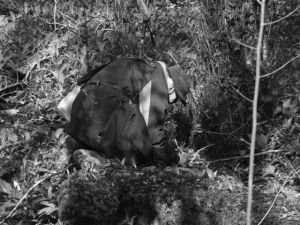 Figure 1 Ron Boyce searching for Phenacolimax major in Bridford Wood (Keith Alexander)
Figure 1 Ron Boyce searching for Phenacolimax major in Bridford Wood (Keith Alexander)
